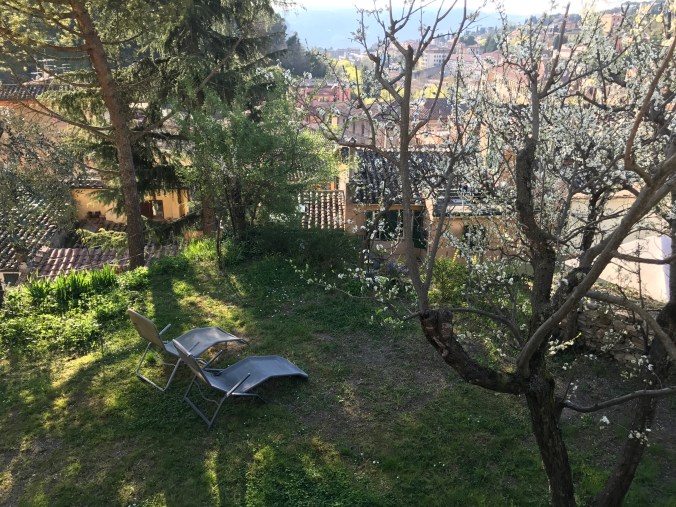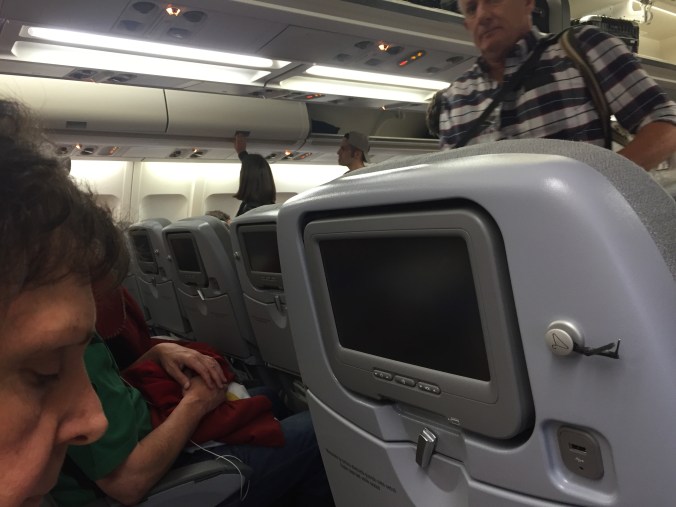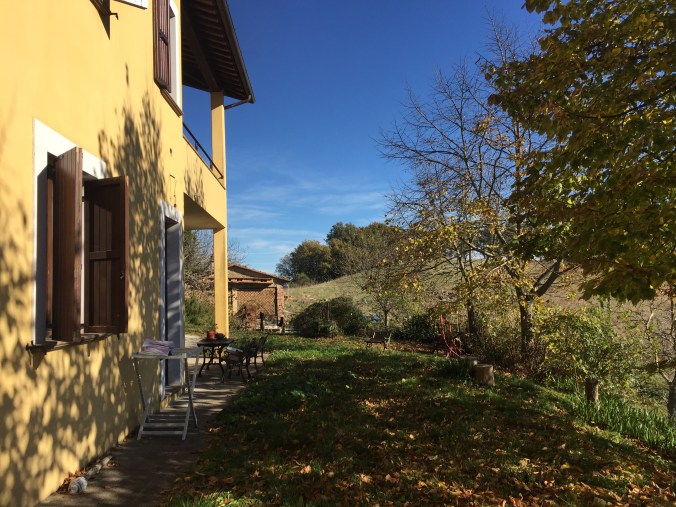 In the heart of the city, an oasis
In the heart of the city, an oasis
We left a cold New York City on Tuesday, a gray day more in keeping with February than late March. And landed in Rome, where it was sunny and approaching 20 degrees C, or 68 Fahrenheit. The weather wasn’t the only incredible thing. If you’ve ever arrived in Rome’s Fiumicino airport, you know what a hell it can be. Not now–spotless, modern, fun to look at. EU citizens can scan their passports and avoid the bored agents. We were through passport control in a few seconds, and got our bags a few minutes after that.( I’m scarred; I’ve seen grownups sit in the old baggage claim area crying.)
I honestly don’t remember much of the drive from there to Perugia; I was so jet-lagged and started to lose it about 25 miles from our destination. Somehow I managed to pilot the Renault Clio close enough to our place, and we survived.
They call Umbria “the green heart of Italy,” and it’s true. Really true, right now. It’s green. How green is it? It’s as though someone turned the color saturation on an old color TV way up. I thought it was my green-lensed sunglasses upping the color, but no. Green. Verde. Vert. Grün. And bright red poppies. It’s really spring here.
Walking around today, I was into another kind of green—green spaces in the middle of the city. In any Italian city, there are lots of hidden spaces: courtyards, cloisters, gardens. In Perugia, because of the hills, these hidden places aren’t that hidden. You just have to walk around, and in between the terraced buildings, you can see patches of green. A beach chair here and there, a trampoline for the kids, a table under a tree.
 I’m really trying to take a break from the all-Trump, all-the-time U.S. news, but I did see the headlines about El Cheeto Loco’s rollback of environmental regs. And it’s just weird, because climate change is a big deal in Europe. And so is some degree of awareness of energy use. You see solar panels everywhere. My favorite application is for the car ports you see at the highway rest stops.
I’m really trying to take a break from the all-Trump, all-the-time U.S. news, but I did see the headlines about El Cheeto Loco’s rollback of environmental regs. And it’s just weird, because climate change is a big deal in Europe. And so is some degree of awareness of energy use. You see solar panels everywhere. My favorite application is for the car ports you see at the highway rest stops.
Perugia, like lots of European cities, limits traffic in its core. It can be a pain. We live in the historic center, and we literally can’t drive up our street with our rental unless we want to be fined. So we have to come up the back way and park outside the city gate—but it’s not such a big deal. We can manage.
Another thing we’re starting to see are electric car charge points. Right now, the only electric cars you see are Smart cars and Renaults, but there will be more in the next few years. And they’re doing bike sharing here, which made me laugh—it’s seriously hilly here—until I realized that the bikes have little electric motors to help you get up these hills.




 A couple of summers ago, our younger daughter came with us to Perugia and took a friend along. Another friend joined them there. We have one bedroom, a living room, and a kitchen. You do the math. If you want it expressed like kids are supposed to do these days with math sentences, it could look something like this: Apartment+3 guests=no living room.
A couple of summers ago, our younger daughter came with us to Perugia and took a friend along. Another friend joined them there. We have one bedroom, a living room, and a kitchen. You do the math. If you want it expressed like kids are supposed to do these days with math sentences, it could look something like this: Apartment+3 guests=no living room.

 So I misspoke. More travelogues and adventures will come after this, notwithstanding the above shot of the 1962 cult movie Il Sorpasso (courtesy of Wikipedia italiano; this is in the public domain). For the uninitiated, it’s a buddy/road trip movie that evokes a lost world, when Italy was La Dolce Vita and enjoying the economic miracolo.
So I misspoke. More travelogues and adventures will come after this, notwithstanding the above shot of the 1962 cult movie Il Sorpasso (courtesy of Wikipedia italiano; this is in the public domain). For the uninitiated, it’s a buddy/road trip movie that evokes a lost world, when Italy was La Dolce Vita and enjoying the economic miracolo.


 Left, the guys pose on a chilly day in August 1983: me, Federico, Antonio (aka Toto), and Franco.
Left, the guys pose on a chilly day in August 1983: me, Federico, Antonio (aka Toto), and Franco. Here, Toto inspects what eventually became our apartment in Perugia, with its own, real, actual gas main connection.
Here, Toto inspects what eventually became our apartment in Perugia, with its own, real, actual gas main connection.

 Here’s Perugia, from the roof of the Mercato Coperto (covered market). Until the recent construction, it was a great place for an aperitivo. New Yorkers, eat your hearts out: Aperol spritzes for €5, or about $5.25.
Here’s Perugia, from the roof of the Mercato Coperto (covered market). Until the recent construction, it was a great place for an aperitivo. New Yorkers, eat your hearts out: Aperol spritzes for €5, or about $5.25.









